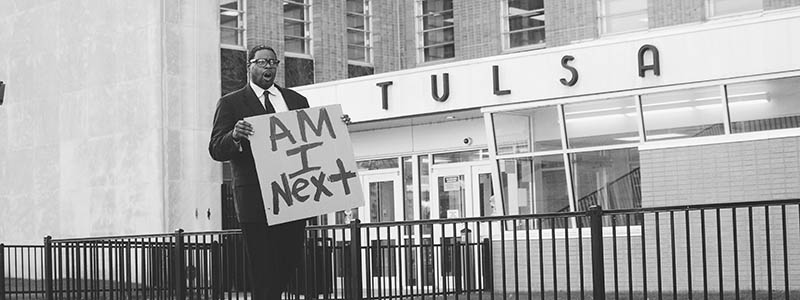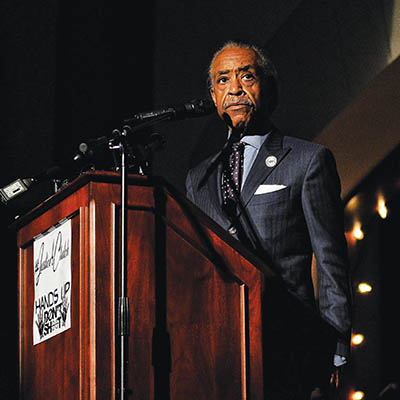Searching for justice, praying for peace
In the wake of Terence Crutcher’s death, a series of rallies, vigils, and protests
Marq Lewis of We the People Oklahoma and protesters at the 9/26 100 Bad Dudes Rally
Joseph Rushmore
On Tuesday, September 27, a thunderous flock of news helicopters chopped through the Oklahoma humidity above Tulsa’s downtown, while onlookers stood on rooftops and protesters blocked the intersection of 2nd and South Cincinnati. Not two years since the shooting of Eric Harris, another unarmed black man, Terence Crutcher, had been killed by police, and the Reverend Al Sharpton was here to lead a community rally.
Outside the Greenwood Cultural Center, on the same ground where, in 1921, hundreds of black Tulsans were massacred by white residents, a growing crowd sought shade. The overall mood was similar to the stuffy climate, but it relaxed when McFadden and Whitehead’s “Ain’t No Stoppin’ Us Now” blared from the PA. Smiles and chatter increased as people packed in towards the podium and the multitude of news station microphones in front of it. A local pastor took the stage, asked everyone to grab the hands of their neighbors, and bow their heads in prayer.
“We come to you today, God, to pray that justice will be served in our city and all across this nation,” she said, “and we pray that you would touch the hearts and minds of those that you have put in charge over the nation and over the Earth.”
As her prayer continued and her voice raised, the crowd exclaimed “Hallelujah,” and “Yes,” raising their volume to reflect her intensity.
“And we pray, God, we pray for reconciliation, and we pray for justice, in the name of Jesus.”
Then, in the middle of the prayer, a siren sounded.
“Blue lives matter!” yelled a counter-protester across the street through a megaphone. “Blue lives matter! Stop falling for race baiters!”
A woman near me cried “Lord Jesus, no!” and began sobbing. Several people broke from the crowd and headed towards the two men across the street, one of whom held a sign that said “every Muslim is a terrorist.”
Another speaker urged the crowd to ignore the demonstration across the street.
“One of the enemy’s biggest tricks is to distract and divide us,” he said, “and I ask you to pay them no mind.”
On September 16, 40 year-old Terence Crutcher was shot and killed by officer Betty Shelby near 36th Street North and Lewis. No weapon was found on his person or in his vehicle. Three days later, dash cam and helicopter footage of the incident was released by police, who first showed it to Crutcher’s family and north Tulsa community leaders. Petitions asking for Shelby’s arrest quickly gathered signatures and six days after Crutcher’s death, Shelby was charged with first-degree manslaughter.
Although footage of the incident was quickly released, the lack of Shelby’s own dash cam footage, coupled with inaccurate early reporting, sent speculation spinning. The death was quickly politicized and absorbed into the fabric of a larger, national narrative involving use-of-force training, systemic racism and the relationship between law enforcement and people of color.
Shouts of “comply or die!” came from the pro-law enforcement faction, who believed and circulated police claims that Crutcher reached into his car window and showed signs of being high on PCP. Attorney Benjamin Crump, who is representing the Crutcher family, held a press conference to dispel this rumor, and presented a still photo from the footage that shows Crutcher’s blood splattered on what appears to be a closed window. Police countered this claim and said his window was down about five inches. Initially, media analysis (including an editor’s letter in The Tulsa Voice) held the idea that Crutcher was merely having car trouble when Shelby happened upon him and drew her weapon. 911 transcripts revealed multiple reports of an abandoned, running vehicle in the middle of a road, and an erratic man yelling “it’s gonna blow.”
Video shows Crutcher, arms in the air, slowly moving towards his vehicle as four cops, including Shelby, close in on with him weapons drawn. He lowers his hands shortly before the fatal shot is fired.
Just four days after Crutcher’s death, while speculation and tempers swirled in Tulsa, police in Charlotte, North Carolina fatally shot Keith Lamont Scott. In less than 24 hours, Charlotte was in flames, and videos of the riots, including an alleged racially motivated mob attack on a white man, fueled fears of violent protest in Tulsa.
Rumors of a Black Lives Matter protest on Highway 169 by 71st Street South circulated on Facebook, and prompted a group of men to set up near the intersection to counter-protest. A video of a protester at the Tulsa County Courthouse stating “A good white man is a dead white man” made headlines on conservative blogs.
Another Tulsan, Chris Vermillion, became infamous when a racist Facebook post (“Better remember the last time blacks got rowdy in Tulsa ... they all died…we don’t play that round here…”) went viral. Vermillion deleted the post and offered an apology, but his remarks were representative of an increasingly fearful section of Tulsa’s populace.
But something amazing happened: Tulsa rallied and peace prevailed. Protesters channeled their sorrow and outrage into vigils for justice for Crutcher, benefits for his family, community meetings, and peaceful protests calling for Shelby’s arrest, which were quickly answered. The world took note.
Both CNN and the LA Times ran articles drawing comparisons between Charlotte and Tulsa, praising our leaders and citizens for their respective transparency and temperament. President Obama called Mayor Bartlett and complimented him on the city’s handling of the tragedy.

Back at the Greenwood Cultural Center, after the “Blue lives matter!” interruption, Tulsa Police established boundaries between the protests. Several men walked back from the counter protest, and one of them hugged an officer.
Speakers following the pastor included the Crutcher family’s legal team and Terence Crutcher’s sister, Dr. Tiffany Crutcher. Throughout the rally, each one of them commended Tulsa’s peaceful grieving process.
“Throughout this ordeal, the entire city has been so supportive ... people of every background, every culture, every ethnic group,” Dr. Crutcher said to the crowd. “And I want to say that the intent of this rally is to promote healing, not just here in Tulsa, but across the nation. I believe we’ve done that, and set the tone of peace, unity, and healing.”
“This isn’t a war against police,” she continued. “We honor our men and women in blue. But when they said my brother looked like a ‘bad dude’? This is a war against bad cops.”
State Representative Regina Goodwin took the podium next. “We’re first about love, we’re about justice, and we’re about it coming swiftly,” she said. “And we’re gonna show everyone around the country that we’re going to do this differently, and get a better result.”
Between the speakers, chants of “peace!” rang through the crowd. As Sharpton’s appearance grew closer, a few in the crowd began counter-chanting, “No justice, no peace,” injecting an element of hard reflection into the rally’s good vibrations.
Many people, locally and nationally, praised Tulsa District Attorney Steve Kunzweiler for quickly charging Shelby, but her quick release on bond and her defense’s assertion she shot Crutcher due to momentary hearing loss have raised concern over the possibility of eventual justice. On September 30, she pled “not guilty” to her manslaughter charge.
In the moments leading up to Sharpton’s time at the podium, people began to doubt Sharpton’s arrival. “I told you he wasn’t coming,” a man next to me said into his phone. The counter-protester’s earlier order to “Stop falling for race baiters,” summed up how some whites feel about Sharpton, but disdain for the Reverend isn’t neatly drawn along racial lines.
Local rapper Earl Hazard has organized benefit concerts for the Crutcher family, but refused to attend Sharpton’s rally. “I don’t like him, because of what he hasn’t done,” Hazard said.
Hazard, who originally planned to confront Sharpton at the rally, said “Everything [Sharpton] does is just for media and propaganda.”
Vanessa Hall-Harper, who led a campaign for City Hall to create an African American Affairs Commission, told me she didn’t mind Sharpton’s presence in Tulsa, but wasn’t sure why he came. “Any national attention for this is good, but we were already handling everything well.”
Goodwin seemed to understand the controversial nature of Sharpton when she addressed the crowd.
“I’d like to say to all of the folks saying, ‘we don’t need any outsiders coming in here,’ understand this,” Goodwin said. “The wheels of justice turn slowly, and when you have folks with experience and folks that care, and folks that can bring to the table what needs to be brought to the table ... we need anyone to come into this town that is about justice. And we should be welcoming them.”

Sharpton finally took the stage. Like all speakers before him, he commended Tulsa’s response, before discussing the tactics of the opposition.
“I’ll tell you what they’re going to do,” he said. “They’re going to say we’re violent, when we’re peaceful, that we’re anti-white, when there are whites that march with us. We’re not anti-white, we’re not anti-police ... we are anti-injustice.”
“I want to commend the local folks for taking one step,” he continued. “They put the video out right away, which they won’t do in other cities, and I congratulate you on that first step. But now you’ve got to go into that second step and that third step,” he said, invoking the cry of “no justice, no peace.”
“When I got off the plane today, a man asked me why I was in Tulsa,” Sharpton said. “I told him I thought y’all were looking for a ‘bad dude.’ Let’s march.”
The crowd, now around 400, took to the street with a roar of laughter, and began to march past the Blue Lives Matter protesters while chanting “Hands up, don’t shoot!”
“Yes! Hands up!” they yelled. “Raise your hands to God and praise him,” said the man who earlier interrupted the group prayer. “Praise God, instead of the man you’re praising who deserved to be shot!”
To this, a student from the Langston Hughes Academy politely responded, “he deserved to be arrested, not shot.”
That sentiment was echoed on a sign bobbing ahead of me that read: “Didn’t have to kill him!” Other signs in the mass declared “I’m a vet, not a threat,” and “I can’t calm down, I have black sons.” One simply asked, “Am I next?”
As the crowd marched, squad cars pulled up to intersections to secure the participants’ safety. A woman warmly told a cop to “have a good night,” and received a cold leer in return. Still, some cops could be seen shaking hands with passing protesters, displaying genuine kindness. In stark contrast to Charlotte, riot gear was nowhere to be seen.
The March ended in front of City Hall, completely stopping traffic. A white man in a Thundercats t-shirt grimaced at the marchers from the City Hall steps, pointing his thumb down in disapproval. A woman approached him and began screaming “Don’t shoot!” in his face, until a man pulled her away. “Don’t worry about them, that’s what they want,” he said.
Amid the loud drone of helicopter blades, Sharpton spoke of peace, unity, and justice, before concluding the rally. As the crowd dispersed, chants of “Hands up, don’t shoot!” could still be heard, but another chant had outgrown it in popularity and intensity. As the throng splintered into smaller groups, you could hear powerful yells of “No justice, no peace,” echo through downtown.
View our gallery on Tulsa's response to Terrence Crutcher's death here.
For more from Mitch, read his article on The Frontier's first year.


.jpg)
.jpg)
